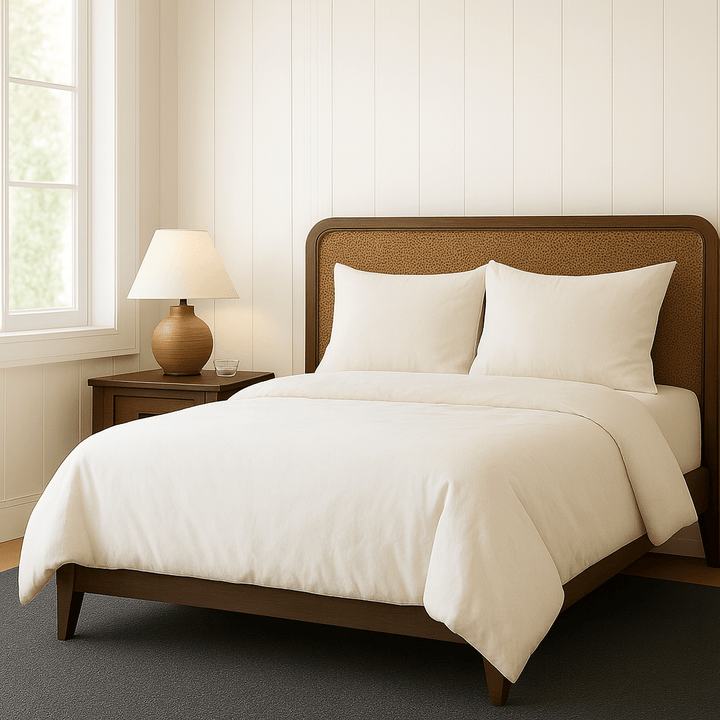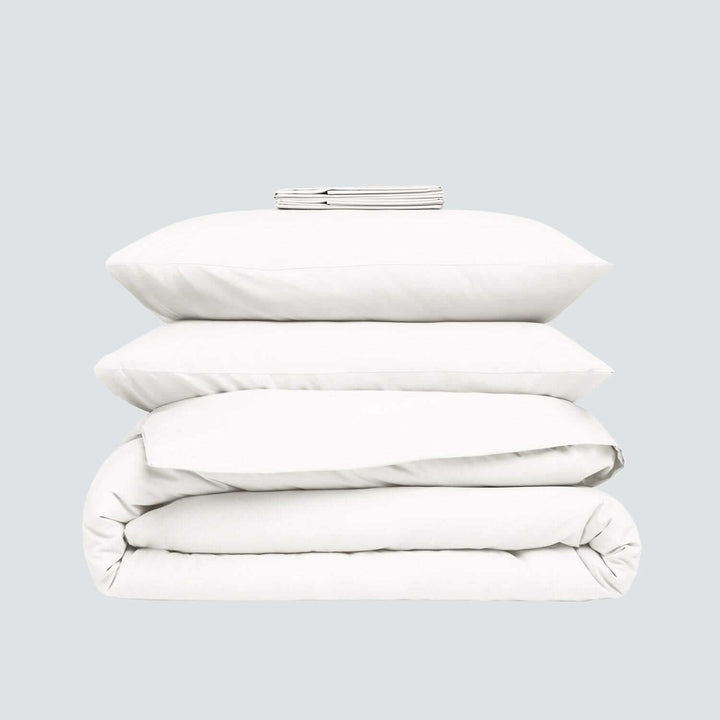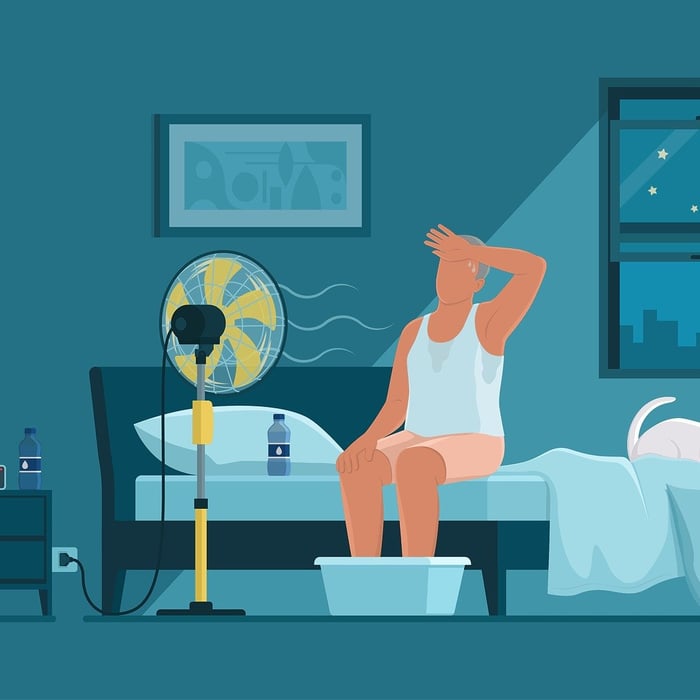Table of Contents
- Moisture Wicking Sheets: The Science of MVT (Moisture Vapor Transfer) and Why Wool Stops Night Sweats
- The Real Reason Night Sweats Happen (It’s Not Just Heat)
- What Is Moisture Vapor Transfer (MVT)? The Simple, Helpful Version
- Why Most Moisture Wicking Sheets Don’t Actually Work
- Why Wool Is the Only Material With True Vapor Transfer (MVT)
- How Wool Outperforms Bamboo & Synthetic Moisture Wicking Sheets
- Why MVT Is the Missing Ingredient in Most “Cooling Bedding”
- The Best Bedding Setup for Anyone Who Wakes Up Sweaty
- Closing Summary
- FAQs on Wool Duvet Inserts, Comforters & Sustainable Bedding
Moisture Wicking Sheets: The Science of MVT (Moisture Vapor Transfer) and Why Wool Stops Night Sweats
If you’re waking up sweaty, damp, overheated, or feeling like you’re sleeping inside a sauna, you’ve probably gone searching for moisture wicking sheets or “cooling bedding” solutions.
The market is full of bamboo, microfiber, and so-called cooling fabrics that claim to wick moisture — but most hot sleepers still wake up drenched.
There’s a reason for that.
These fabrics absorb liquid sweat after you’ve already overheated.
They don’t manage humidity before it becomes sweat.
They don’t stabilize temperature.
And they don’t stop the humidity loop that triggers night sweats in the first place.
To solve night sweats, you don’t need sheets that wick liquid.
You need bedding that moves vapor — before sweat ever forms.
This is where the science of MVT (Moisture Vapor Transfer) comes in — and why wool is the only natural material that actually stops night sweats instead of just managing the aftermath.
The Real Reason Night Sweats Happen (It’s Not Just Heat)
Night sweats don’t start with heat.
They start with humidity trapped in your microclimate — the small bubble of air between your skin and your bedding.
Here’s what happens:
Your body gives off heat
Bedding materials trap humidity instead of releasing it
The humidity has nowhere to escape
Your body overheats
Sweat production kicks in
Sheets absorb sweat → get damp
You wake up clammy, sticky, uncomfortable
Cooling sheets, bamboo sheets, and synthetic “moisture wicking sheets” all focus on absorbing liquid sweat.
But by the time sweat is absorbed, the overheating cycle has already begun.
The real solution is preventing the humidity buildup before sweat forms.
That’s what MVT does.
Organic Wool Comforter | Made in New Zealand, Breathable All-Season Comfort

$342.00
$380.00
Sleep naturally better with our organic wool comforter Unlike down or synthetic comforters that trap heat, this lightweight wool design wicks away moisture and prevents overheating, so you stay cool, dry, and deeply relaxed. It’s comfort that feels effortless yet… Read more
What Is Moisture Vapor Transfer (MVT)? The Simple, Helpful Version
Moisture Vapor Transfer (MVT) is the ability of a material to pull vapor (invisible moisture) away from your skin before it becomes liquid sweat.
Great MVT =
less humidity
fewer sweat spikes
stable temperature
deeper sleep
dry, breathable microclimate
Poor MVT =
humid air trapped around your body
overheating
sweating
clammy sheets
constant sleep disruptions
Most bedding fails the MVT test — even if it’s marketed as “moisture wicking.”
Why Most Moisture Wicking Sheets Don’t Actually Work
The top-searched moisture-wicking bedding materials — bamboo, cooling cotton, cooling microfiber — all miss the mark for one simple reason:
They move liquid, not vapor.
They wick sweat after it forms, but they can’t prevent overheating.
Here’s why:
Bamboo (viscose/rayon)
Feels cool at first but holds on to humidity → warms up quickly.
Medium breathability. Low vapor release. Moisture stays close to the body.
Cotton (including percale)
Breathable on the surface, but absorbs liquid not vapor.
Once cotton gets damp → airflow collapses.
Synthetics (“cooling” polyester blends)
Moisture-wicking on paper but zero vapor transfer.
Seals in humidity → the worst option for night sweats.
This is why people who buy moisture-wicking sheets still wake up drenched.
The fabric isn’t managing the root problem: humidity accumulation.
Regenerative Organic Cotton Sheet Set – Soft, Breathable & Sustainable

$189.00
Softer Sheets. Cleaner Sleep. Our organic cotton sheet set are simply better for the earth, and for your sleep. Grown on low-impact regenerative farms that actively heal the soil, our cotton is then woven and finished responsibly. This process eliminates… Read more
Why Wool Is the Only Material With True Vapor Transfer (MVT)
Regenerative New Zealand wool is fundamentally different from every other bedding fiber — natural or synthetic.
Here’s why it crushes moisture-wicking sheets for real-world night-sweat relief:
1. Wool Moves Vapor Before Sweat Forms (The MVT Superpower)
Wool is the only bedding material that absorbs 30–35% of its weight in vapor, not just liquid moisture.
This means:
humidity is removed before you feel damp
vapor moves away from your body all night
night sweats never escalate
sheets and comforters stay dry
your microclimate stays balanced
No bamboo sheet.
No “cooling microfiber.”
No synthetic moisture-wicking fabric.
None of them can do this.
2. Wool Releases Moisture Back Into the Air
Wool doesn’t hold onto moisture.
It actively evaporates vapor outward, away from your skin and away from your bedding layers.
This creates:
a dry sleeping environment
consistent airflow
less heat retention
fewer sweat triggers
This is why wool bedding feels dry and comfortable even in humidity-heavy climates.
3. Wool Regulates Temperature All Night Long
Hot → wool releases heat.
Cool → wool insulates lightly.
It adapts to you in real time — something “cooling bedding” simply can’t do.
This dynamic thermoregulation breaks the overheating cycle entirely.
4. Wool’s Natural Crimp Keeps Airflow Moving (Even Under Pressure)
Unlike bamboo, cotton, or down:
wool fibers are springy
they create natural air pockets
they don’t collapse when you put weight on them
So airflow continues all night long.
More airflow = better vapor movement = fewer sweat spikes.
Organic Wool Duvet Insert & Bedding Set | Sustainable & Regenerative | Made in New Zealand

$475.15
$559.00
Cooler Nights & Deeper Sleep — All Year Long If you’re searching for the perfect organic wool duvet insert and wool bedding set, this complete set includes both the duvet insert and cover. Our organic wool duvet set, designed using… Read more
How Wool Outperforms Bamboo & Synthetic Moisture Wicking Sheets
Here’s the simple breakdown:
| Feature | Bamboo Sheets | Synthetics | Moisture Wicking Sheets | Wool Bedding |
|---|---|---|---|---|
| Vapor Transfer (MVT) | Low — | None ✖ | Low — | Excellent ✔ |
| Liquid Wicking | Medium ✔ | High ✔ | High ✔ | High ✔ |
| Breathability | Good ✔ | Poor ✖ | Good ✔ | Excellent ✔ |
| Humidity Control | Low — | None ✖ | Low — | Outstanding ✔ |
| Temperature Regulation | None ✖ | None ✖ | None ✖ | Dynamic ✔ |
| Best for Night Sweats | Not ideal — | No ✖ | Not ideal — | YES ✔ |
Nothing else even comes close.
Why MVT Is the Missing Ingredient in Most “Cooling Bedding”
Most cooling bedding — toppers, sheets, or comforters — rely on:
gel pads
phase change materials
icy fibers
initial cool-to-touch sensations
None of this stops humidity from rising.
None of it manages vapor.
None of it regulates temperature.
These materials cool you for 10–20 minutes…
Then the humidity builds, the temperature rises, and the night sweats come back.
Wool prevents the problem instead of reacting to it.
Sustainable & Regenerative Bedding Bundle | No More Night Sweats, Just Deeper Sleep

$598.40
$748.00
Cooler Nights & Deeper Sleep — Every Night Upgrade your rest with the only sustainable bundle designed with regenerative New Zealand wool and organic cotton for all-season comfort. This eco-friendly combo is made to naturally wick away heat and moisture,… Read more
The Best Bedding Setup for Anyone Who Wakes Up Sweaty
To maximize MVT and reduce night sweats:
1. Wool Comforter
Your primary temperature-regulation engine.
2. Organic Cotton Sheets
Soft, breathable base layer that doesn’t trap moisture.
3. Light Layering
Let the wool manage the microclimate.
4. Balanced Room Humidity
Optimal humidity = fewer sweat spikes.
This combination solves the root humidity problem and transforms your sleep quality.
Why Evaporative Cooling Matters More Than “Moisture-Wicking” Claims
Most sleepers don’t realize how much their body depends on evaporative cooling — the process where moisture leaves the skin as vapor.
If your bedding blocks that vapor, your body has no choice but to sweat more in an attempt to cool itself.
This creates a feedback loop that even the best moisture-wicking sheets cannot break. Wool excels because it supports evaporative cooling naturally, letting your body maintain temperature with far less effort.
Why MVT Matters Most for Menopause, Hormonal Heat Swings & High-Humidity Climates
This is especially important for hormonal fluctuations, menopause, high-humidity environments like the South, athletes with elevated metabolic heat, or anyone with disrupted thermoregulation.
Wool’s natural MVT performance gives these sleepers stable sleeping temperatures and significantly fewer night wakings. When your bedding helps your body cool efficiently, you don’t just sleep drier — you sleep deeper.
Closing Summary
If you’re tired of moisture-wicking sheets that still leave you waking up sweaty, it’s because they’re focused on liquid — not vapor.
Wool is the only material that manages vapor, humidity, airflow, and temperature regulation at the same time.
That’s why regenerative wool is the top choice for hot sleepers, night sweats, and anyone who wants deeper, drier, more restorative sleep.
Cooler nights. Fewer disruptions. Better mornings.
Explore Our Bedding For Hot Sleepers Collection
FAQs on Wool Duvet Inserts, Comforters & Sustainable Bedding
What is Moisture Vapor Transfer (MVT) in bedding?
Moisture Vapor Transfer (MVT) is the process that allows your body heat and moisture to escape your sleep microclimate as vapor — long before it turns into liquid sweat. When bedding materials have high MVT, they let humidity move freely away from your body, preventing the clammy, damp feeling that wakes hot sleepers. Wool is exceptional at this because its fibers are naturally crimped and porous, allowing vapor to pass through continuously without collapsing under your body weight.
Why is MVT more important than “moisture wicking” for night sweats?
Most moisture-wicking sheets only react once sweat appears. They pull liquid off the skin, but they do nothing to stop the sweating in the first place. High MVT bedding—especially wool—prevents sweat from forming by managing vapor before it condenses. This is the difference between staying cool all night vs. waking up soaked at 2 a.m.
Do moisture-wicking sheets actually help hot sleepers?
They help a little, but only after the sweating begins — which is why so many people still wake up sweaty even with moisture-wicking sheets. These fabrics (usually bamboo, microfiber, or performance synthetics) handle liquid sweat, not vapor. Wool’s MVT performance stops overheating at the root by preventing humidity buildup, which moisture-wicking sheets cannot do.
How does wool naturally support MVT?
Wool fibers can absorb up to 30–35% of their weight in moisture vapor without ever feeling wet. This vapor is pulled into the fiber core, then released into the air as your temperature shifts. It’s a dynamic, self-regulating system that no plant-based fiber or synthetic fabric can replicate. This is why wool bedding stays dry to the touch even when humidity rises.
Why do bamboo and cotton sheets fail during night sweats?
Cotton and bamboo absorb liquid moisture, not vapor. Once sweat appears, these sheets soak it up like a sponge and hold onto it, flattening their airflow pathways. This traps humid air around your skin, increases sweating, and leads to that sticky, damp, uncomfortable feeling. They breathe — but they don’t regulate.
Does wool work for people who wake up drenched in sweat?
Yes — especially for severe night sweats or hormonal changes (menopause, thyroid conditions, postpartum, high athletic metabolism). Wool’s MVT performance keeps bedding dry, prevents humidity spikes, and stops that cold-sweat crash when damp sheets meet cool air. The result is steadier temperature, fewer wakeups, and deeper sleep cycles.
Will wool make me too warm in summer?
No. Wool isn’t “warm bedding” — it’s responsive bedding. When you overheat, wool releases heat and vapor quickly, preventing sweat from forming. In hot climates or warm bedrooms, it actually keeps your microclimate cooler than cotton, bamboo, down, or synthetic alternatives. That’s the power of true thermoregulation.
What bedding materials have poor MVT?
Down, polyester, microfiber, viscose rayon (bamboo-derived), and tightly woven cotton all score poorly in MVT. They trap humidity, collapse under pressure, and prevent vapor from escaping. This leads to overheating, sweating, and disrupted sleep. These materials often feel cool for the first 10 minutes — until humidity builds.
Can MVT help couples with different sleeping temperatures?
Yes. High-MVT bedding like wool adapts to each person’s temperature independently. It moves vapor away from warmer sleepers, prevents spikes in humidity, and balances the microclimate across the bed. Couples who fight over blankets or run at different temperatures benefit hugely from wool’s self-adjusting performance.
What’s the best bedding setup for maximizing MVT?
For the strongest vapor transfer and lowest risk of night sweats:
Wool comforter: your primary MVT engine
Organic cotton sheets: breathable base layer
Minimal layering: avoids trapping vapor
Open airflow: allow wool’s crimped structure to breathe
Healthy room humidity (40–50%) improves natural evaporation
This combination gives your body everything it needs for true heat release, not just moisture wicking.




